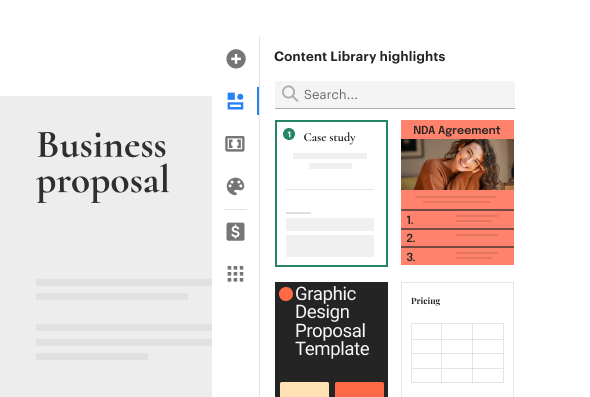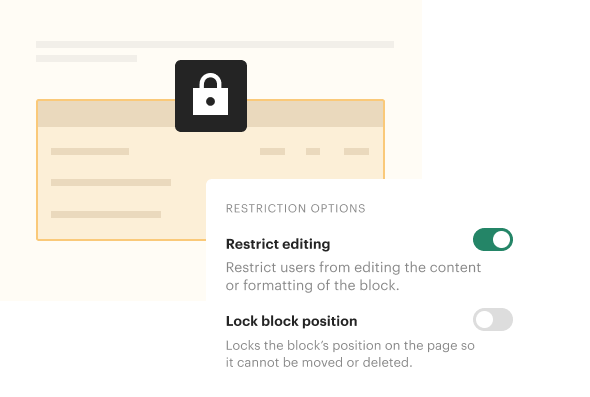
Falck Ambulance shortens their billing cycle by six months
Finish your demo booking
Looks like you haven't picked a time for your personalized demo. Pick a time now.
Select date and time
Complete 87% more docs every month in 50% less time. Use PandaDoc to automate tedious, repetitive tasks and build efficient document workflows across your entire organization.

Document automation software shortens your document assembly time and helps sales reps close more deals.
Your brand is the face of your company. From your logo and color palette to your messaging style, every aspect of your documents tells a story about what your company represents.
Our document automation solution comes packed with user-friendly drag-and-drop features that allow you to create a consistently on-brand experience across all of your business documents.
PandaDoc is a perfect example of documentation automation software that makes it ridiculously easy to create stunning business documents with zero coding required. Right out of the box, we offer over 750 professionally designed templates that you can quickly customize to meet the unique needs of your team.

The beauty of PandaDoc templates is that anyone in your organization can create new documents quickly and completely on their own. Once you’ve added your brand elements into the content library and to your selected templates, you can save the templates to be reused by your colleagues so nobody ever has to reinvent the wheel.
By using our automation and document assembly software, you will be spending less time creating and editing new documents, so your team will finally be able to free up enough time to focus on more complex aspects of their work. Using templates to create new documents is just one of the many ways PandaDoc helps save your team tons of time while taking monotonous tasks off their plate.
Start a free 14-day trial today to see PandaDoc in action!

PandaDoc seamlessly integrates with over 30 business tools you’re probably already using:
Lean on the impressive array of PandaDoc integrations for state-of-the-art document workflow automation tailored to the specific needs of your team.

Whether you’re looking for top-notch accounting document automation software or something that simply allows you to work from home more often, PandaDoc has got you covered. PandaDoc is accessible from any device and any location, so you can collect payments and legally binding eSignatures with unparalleled ease.
Spend less time making phone calls, manually entering data, or meeting with people face-to-face just to get your much-needed signatures.

When documents are ready for review, stakeholders typically need to get them approved and enter all relevant data into the system.
Our document automation tool dramatically shortens the time it takes to complete a document from A to Z by embedding each approval necessary into one comprehensive, coherent, automated documentation workflow.

Avoid the usual headache of keeping document versions in check in a multi-party environment with several key signers and multiple contributing reviewers.
Use PandaDoc for complete automation of document processing with any number of people and workgroups involved. Update the source document at any time to make the changes visible for everyone and never have to deal with version conflicts leading to costly and time-consuming repeat work.

Our document automation platform effectively bridges gaps between different departments and makes for substantially improved collaboration during complex document reviews.
A great solution for financial document automation and, arguably, the best document automation software for law firms, PandaDoc makes highly complex projects manifestly easier by offering just the right tools for seamless cross-departmental collaboration.
If you are getting bogged down with zillions of documents in your law firm or legal department, you can find an affordable legal document automation app on the market that will do its job, but none of them will stand a chance against the comfort and functionality of PandaDoc.
Still not convinced? Schedule a 1-on-1 demo for a detailed tour of our product!

When it comes to large-scale automation of documentation flows, every error can have a huge negative impact. PandaDoc streamlines document creation and automation in a way that minimizes the chance of human errors slipping into your document exchange.
This new efficiency comes with an added bonus of improved accuracy, which is especially important if you want to automate finance documents or automate a document workflow for your legal department, where precision comes to the forefront.

Enjoy the benefits provided by automation with software solutions from PandaDoc and attain considerable savings in every department.
Shorter and more effective sales cycles translate into extra revenue, more closed deals, higher throughput, and less rework — something that every manager or business owner can really appreciate.
The best document automation software is one that saves your precious time and helps you make more of the time you use — and PandaDoc does exactly that!

PandaDoc is not just about automation of documentation, template reuse, and effective collaboration between various parties. It is also about ensuring document security and compliance where it is required.
Our document assembly service will save you the trouble of checking and rechecking every document for alignment with your own style guide or compliance with industry-specific requirements for disclaimers, notes, warnings, and other elements.
On the security side, PandaDoc has got you covered as well: all your documents are reliably stored in the Amazon cloud with multiple levels of protection and permission-based access that you fully control — something you won’t find in free doc automation software.

Thousands, 50,000 actually, use PandaDoc each day to make their document process painlessly simple.
Document automation software automates the tedious and repetitive task of creating important business documents every day. Not only does it free up your team members’ time and let them focus on higher-priority work, but the end results are more professional-looking and on-brand documents, complete with interactive pricing tables, videos, GIFs, and more.
Security is our number one priority. We go above and beyond to ensure the safety and privacy of every document created in our software. We’re SOC 2 Type II certified, as well as HIPAA, FERPA, ESIGN, UETA, and GDPR compliant. Our servers are handled by Amazon AWS and designed for maximum security.
We make it extremely easy to integrate PandaDoc with other tools. However, some tools are more complex, and integrating the software can take a few steps.
For some tools, all you have to do is go to their marketplace, find PandaDoc, and hit “Install.” Other tools — especially those that offer more customization options — may require a few additional steps to connect to PandaDoc. And if the product is not supported directly, you can always build a custom integration using our powerful API to connect PandaDoc to virtually any system you are running.
Although the exact steps you need to take to integrate PandaDoc depends on which business tool you’re using, our support team is always ready to help by walking you through the integration process step-by-step.
Dozens of market leaders have already chosen PandaDoc as their document automation platform of choice, including Tata Steel, Autodesk, Rakuten, TomTom, and Bonusly. Now could be your chance to join the club!
User-friendly drag-and-drop capability and customizable templates allow you to create media-rich documents in 50% less time. On average, our customers also see 87% more completed docs every month. And if those states aren’t enough for you, we see an increase of up to 36% in close rates across our customers. Imagine your current workflow cut in half — that’s a lot of extra time that you’d be able to use for more important things, like scaling your business.
PandaDoc’s document automation software isn’t just a time-saving tool though. It will also save your team some headaches and help build automated workflows that puts mundane tasks on autopilot. In fact, some customers report an average of 65% reduction in document creation time (even more than the 50% listed above!) and a 30% reduction in time-to-close. You can learn more about how much time our software saved different companies by checking out our Case Studies.
PandaDoc can be used for any digital document that your business needs to create, send, sign, or track. Customers vary across a wide range of industries including tech, professional services, revenue teams, healthcare, education, and finance. No matter what industry you work in, you can rest assured that your PandaDoc documents will be safe and protected.
Yes. You can count on PandaDoc to collect legally binding eSignatures. We include an electronic certificate with every eSignature so you can have confidence that the information you’re collecting will stand up in court.
Working across borders? Electronic signatures are legally binding in most countries, but to make things even easier, we’ve outlined eSignature laws in various parts of the world here.
Get personalized 1:1 demo with our product specialist.